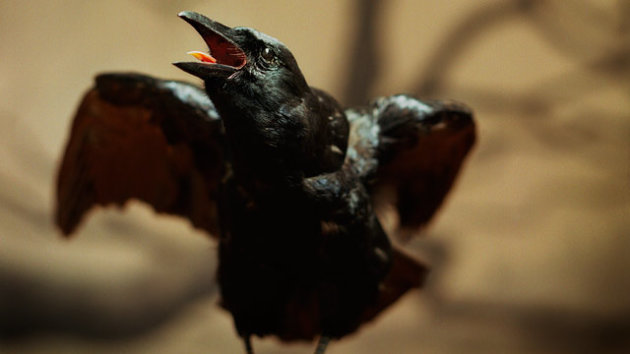The American crow, which in so many ways is so much like humans, is moving from the countryside to the big city, and like humans, it is paying a price.
Stress.
Crows showed little taste for the urban environment until four or five decades ago, when they began a continuing migration into suburbia, and even into the heart of megalopolises that many humans would love to leave. Why are they doing that, and how do they deal with the stress coming from noise, congestion, and too many people?
Animal behavioral ecologist Anne Clark of Binghamton University in New York regularly climbs the trees in the suburbs of Ithaca, along with her students, to borrow newly hatched crows for banding, tagging, and blood testing. She wants to understand why they are becoming city folk, and how they are coping with the stress that surely follows.
But it's not just because she loves crows. It just may be that these amazingly clever birds can tell us whether our cities are fit places for anybody to live.
"By studying the well being of urban organisms, how they adapt and what costs they are bearing from living in a city, we hopefully will be able to build cities that are healthier for all of us," Clark said in a telephone interview.
Urban planners are increasingly interested in how cities function as an ecosystem, she added, so the more we understand how that system serves all of us -- from crows to insects to humans -- the better equipped we will be to build smarter cities.
Crows probably began moving to cities to escape predators, especially great horned owls that attack crows nests in the dark of night.
The American crow is particularly vulnerable to the West Nile virus, which has wiped out about 45 percent of the national population. The bird is considered by experts to be the primary victim, not the primary carrier, of the virus.
Although they seem to be all around us, these birds are very wary of humans, and even learn to recognize individuals who have harmed them in the past.
Kevin McGowan of Cornell University's ornithology lab, with whom Clark began her research years ago, insists that crows know him so well as a distributor of peanuts that they will seek him out and follow him around until he pays up with a handful of -- "unsalted, in the shell" -- peanuts.
Other crows recognize him as the villain that invades their nests to band their young, and they will follow him around, "cawing" loudly and warning other members of the flock until he leaves the area. Crows, like humans, make strong bonds with family and other members of their community, and will warn each other of danger.
Crows are known for their cleverness, especially the famous New Caledonian crows that use tools and have even shown signs of analogical reasoning, concluding that if one tool doesn't work, a similar one might. Scientists from the University of Auckland put meat in a hole and left a stick for the crows to use to retrieve the meat. But the stick was too short. So the crows used the shorter stick to reach a longer stick and then used the longer stick to get the meat.
"Evidence suggests that, from the earliest human stone tools, analogical reasoning has been at the core of human innovation," biologist Russell Gray of the University of Auckland said when that discovery was announced in 2007.
"This hallmark of human intelligence may also be at work in both the great apes and New Caledonian crows and may explain why, out of all the crow species in the world, only these crows routinely make and use tools," he said.
There is no evidence yet that the American crow is quite that clever, but they are still regarded as among the smartest animals on the planet. They have at least 250 different calls -- although they may all sound the same to humans -- and they will care for their young and defend crows that they don't even know, according to McGowan.
But that still begs the question: If they are so smart, why are they moving into urban chaos? Crows and humans can be a hard mix.
"No one is ambivalent about crows," Binghamton's Clark said. "Either you hate them or you love them."
They can be really, really annoying. In early spring, the second I step out of my home crows will scream as though I were a harbinger of death, and they will follow me -- cawing endlessly -- until I leave.
Sometimes, I really dislike them, like a woman Clark recently encountered.
"She said 'I hate these guys,'" Clark recalled. "I said, 'You hate crows because they are exactly like people.'"
Maybe not exactly, but we share many of the same genes, and we are increasingly sharing the same landscape. Clark thinks cityscapes may actually look attractive to a crow flying overhead. Nicely manicured lawns, beautiful golf courses, parks with small lakes and fountains, can be alluring.
And then they land and discover that those golf courses are "managed lands" that don't provide the bugs the crows like to eat, and the lawns are full of chemicals that are unhealthy both to crows and humans, and so they end up looking for lunch in dumpsters.
That may be why the nestlings she and Mcgowan have studied in cities are smaller than those in rural areas, and the protein and the calcium so essential to growth was lower in birds in cities. All that has to lead to stress, but Clark said the birds seem to be adapting to their new environment.
But can they really tell us anything about our ecosystem, and about ourselves?
Maybe they already have.
City crows, Clark said, never move back to the countryside.



No comments:
Post a Comment